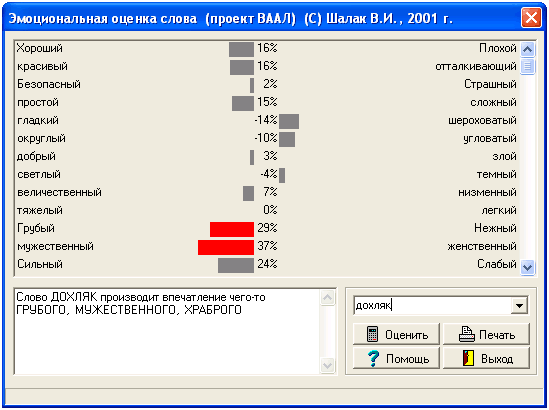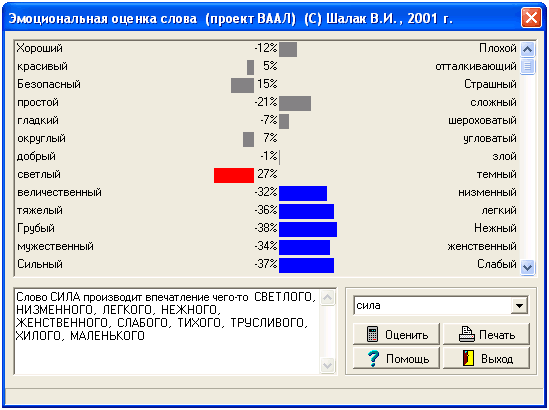|
Artemy Lebedev
§ 94. Dreams come trueJuly 10, 2002 |
|
Let’s take a thing as simple as coining a name for a new product or service. A product’s name may be homonymous with a person’s name or second name. That’s how things are with Bosh, Siemens, Mercedes, Schick, Max Factor, Dolby, Hewlett-Packard, Pininfarina, Bure, Bell, Ericsson, Chanel, Toyota and other folks. |
|
Using the name of a local sight or just the name of the city you are living in is all right, too, which is clearly seen in such brand names as Nokia, Adobe, Palekh, Gzhel, eau-de-Cologne, jeans etc. |
|
You can make up a word whose only value will be its absolute uniqueness and the absence of something similar in any language of the world: Kodak or ABBYY. |
ABBYY picked a name with a set of letters that’s impossible in any other word, which makes it easier to find it on the internet. |
|
You may also write down on a scrap of paper your name, place of birth, the name of a comet that, as you’ve heard, flew past the Earth—whatever—and build an abbreviation or an acronym whose exact meaning will not become news known by every barber the next day: IKEA, YUKOS, radar, scuba, SAAB, FIAT etc. |
Sokr.ru—the most comprehensive vocabulary of Russian abbreviations |
|
Now what do the above listed names have in common? It’s that none of their authors conducted focus group surveys and didn’t order a laboratory research into the impact of malleus on the eardrum in listeners’ tympana. Called it the way they saw fit and that’s it. If there were a method that works, no one would use any other. |
|
In the entire world there are no all-purpose ways of selling things (or reporting something in a manner everybody will find clear) with the help of design, marketing or advertising tools. Therefore the Customer (as the first party) and the Provider (as the second party) every time agree upon something neither of them is sure of. |
|
The Customer’s mind is steeped in mysticism and superstition. As soon as something that’s hard to make sense of comes down the road, the Customer reacts with a positive reflex, like Pavlov’s trained doggy.—Missing the point? I’ll take it. |
|
There is a computer psycholinguistic system called VAAL. It’s used by professionals to analyze texts in the Russian language. You can download your entire database of newspapers of the past year into the program and see how people’s attitude to your mayonnaise has been fluctuating, and whether it’s high time to add some meat to the sausages you’re making. A serious tool for no-nonsense analysts, politicians and economists. |
|
Under the same trademark, a free product called “VAAL-mini” is being distributed. In terms of complexity of use and efficacy, that’s a tinker toy comparable to a daisy used in the binary “loves-me—loves-me-not” play. |
|
Let us now take a look at the results of a phonosemantic test of two words (translated into English). |
 |
 |
|
The word “wimp” has proved to be manly and brave, while the word “strength” has been unveiled as wonky and cowardly. What’s the point of these results? There isn’t any. Nevertheless, in marketing departments of various companies nationwide lots of highly-paid specialists pluck petals off phonosemantic daisies, shedding light on the fortune of an unborn brand. There must be something to push responsibility to: this time around it’s a hi-tech product, an outcome of a protracted linguistic research, a result of scientists’ labor, a computer program—in a word, a bunch of words that may come handy in a report. |
|
By the way, the word VAAL hits a jackpot in this program, getting the maximum amount of positive scores for a host of most desirable qualities. That gives the marketing department another reason to conclude that there are some brands working miracles and affecting consumers’ unconscious in a queer manner, sparking subliminal love to a company. |
|
Both the Customer and the Provider habitually try to shift the responsibility to providence that sometimes takes shape of focus groups, sometimes—frauds peddling formulas used to figure out whether a brand will pan out well, sometimes—cracker barrel astrologers. |
|
You can’t stage a revolution by a focus group poll. |
|
The Consumer is not indicated in the contract, but he’s the one the whole thing is about. After all, the Customer doesn’t give a damn either for the Provider or the Consumer, but has to make his living somehow. So the Customer has to work with the Provider to entice the Consumer. |
|
The Consumer knows or at least can guess that there are Super Customers out there. He also knows that there are Super Technologies out there to inveigle customers at large. Such technologies are generally viewed negatively, but once it comes to the opportunity to benefit by them, customers do an about face and start to feel enthusiastically positive. |
|
There’s subliminal messaging, for example (or the “25th frame effect” as it is called in Russia). In mid-1950s at a drive-in cinema theater in Fort Lee (New Jersey, U.S.) a young man named James Vicary conducted an experiment with an audience using a device popular among psychologists—tachistoscope. He would flash the phrases “Hungry? Eat Popcorn” and “Drink Coke”, each lasting for no more than 1/3000 of a second. Vicary claimed to have boosted concession sales of popcorn by 57.8% and Coca-Cola by 18% as a result. |
Big Secrets, William Poundstone, Quill, NY, 1983 Tachistoscope (Merriam-Webster Online Dictionary) |
|
This statement by Vicary unleashed a storm of protest from the public which was unhappy with the idea of being used as test animals in such an effective experiment. Vicary later confessed that the whole affair had been dreamt up by him. A spike in sales may be due to anything—from seasonal demand to activity of retailers who were tipped off about a buying spree by all viewers. |
|
|
Ever since no one has succeeded in conducting an experiment to prove that too-brief-to-be-seen words flashed on screen are powerful enough to drive people to take actions. The results of psychological research show that a human cannot possibly perceive information faster that in 1/100 of a second. Which means human perception is 30 times slower than the rate that brought a now long-standing myth into being. |
|
It’s worth noting that the use of the term “25th frame effect” is limited to Russia. The term is unknown in the West: instead, they use the term “subliminal message”. At a cinema theater, nobody will adjust the projector to make it show one frame per second more than usual. A periodically recurring frame may be inserted in any video recording, but only the blind won’t see it on screen or monitor. The certainty about the effectiveness of the magical 1/25 of a second is firmly entrenched in people’s minds. There are some believing that if the secret frame’s duration is 1/24 or 1/26 of a second, it won’t work. |
|
The popularity of the “25th frame effect” is also nurtured by the Russian law on advertising whose article 10 reads as follows: “Using subliminal advertising, i.e. the advertising influencing consumers’ perception in a way unconscious for them, including by inserting special video fragments (double sound recording) and in other ways in radio, television, video, audio and cinema products and other products, and the distribution of subliminal advertising otherwise in prohibited”. |
|
The more people believe in myths, the larger will be the scale on which state spoon-feeds them old wives’ tales of this sort. People are prone to believe that a bull runs amok at the sight of a red rag and that an ostrich hides his head in sand. They are inclined to believe that the Y2K bug is a serious problem, that resetting clocks for summer or winter time helps save energy, that there’s the ozone hole, that species are becoming increasingly extinct and it’s getting hotter around the world. The more simple and stupid is the thesis put forward, the more chances it will enjoy popular confidence. |
Here’s another way to deceive oneself: |
|
But why on earth should we be part of this? Why get some program’s approval of a name? Why make sure a housewife picked at random from a certain focus group loves the logo—considering you’d never hire her to do any job? |
|
Why watch a commercial for a fraction of a second? Erect a billboard and gawk at it for a minute. |
|
|
|
